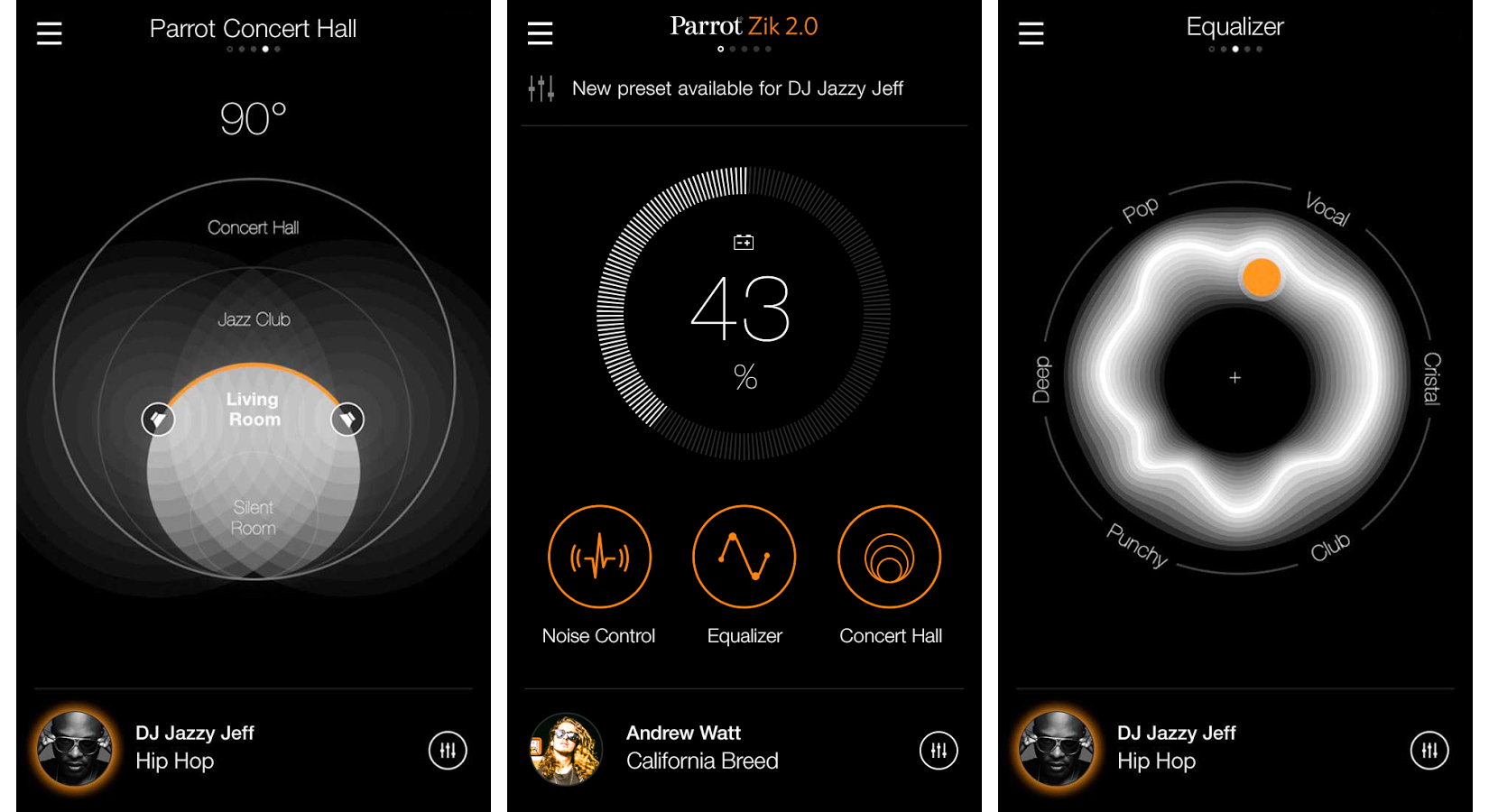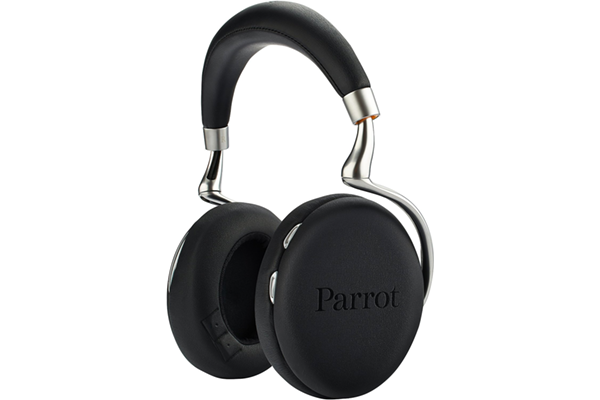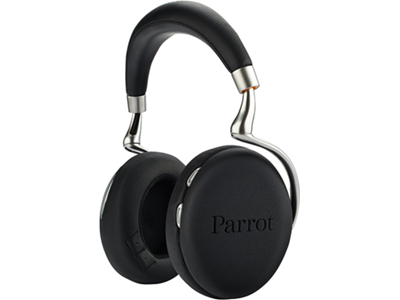Tom's Guide Verdict
The Parrot Zik 2.0 Bluetooth headphones combine head-turning design, improved audio quality, active noise-cancellation and an innovative revamped app.
Pros
- +
Slimmed-down, lighter design
- +
Powerful active noise-cancellation
- +
Easy to use, highly improved app
- +
Great audio quality
Cons
- -
Short battery life
- -
Have to use app to access bulk of the features
Why you can trust Tom's Guide
It was so nice that Parrot had to do it twice. The Zik 2.0 headphones improve on the near-perfect design of the originals, creating a slimmer, lighter and definitely sexier set of cans that could take a turn in the Museum of Arts and Design. But the second-generation headphones are more than a pretty paperweight. Parrot expanded on high-tech features such as adaptive noise-control technology, adjustable soundscapes and professionally tuned audio presets, creating a headphone that looks as good as it sounds.
Design
Somehow, designer Philippe Starck managed to make the second-gen Ziks look even better than the first-gen model. The first things I noticed were the slimmed down ear cups; the bulk has been considerably cut down, making for a more svelte headphone.

This time around, the entirety of the cups has been swathed in black faux leather that's soft and supple and resembles a couple of macarons. The silver-chrome accents have been repositioned to highlight the strategically placed audio ports. Toward the bottom of the right ear cup is a silvery panel housing the power button and microUSB port.
Not much has changed on the comfortably padded headband. It's still wrapped in sumptuous black faux leather, and stamped with the Parrot insignia on top. The ends of the band are capped in a silver aluminum alloy that extends from each side to adjust the fit.
MORE: The Best Headphones Available Now
Although the black leather is striking, I'm glad to see Parrot is offering the Zik 2.0s in a variety of bold colors including blue, yellow, orange, mocha and white.
Controls and Sensors
Parrot has once again skillfully hidden a treasure trove of tech beneath a gorgeous exterior. Like its predecessor, the Zik 2.0 has a touch panel cleverly camouflaged on the right ear cap. An upward swipe increases the volume for music or a caller's voice, while a downward motion performs the opposite function. Swiping to the right or left skips tracks forward or back, respectively.

A quick tap in the center of the panel plays or pauses music, while a double tap answers or ignores calls. Long-pressing will cue up your digital assistant, which varies depending on your mobile device's operating system (Siri for iOS, Google Now for Android). You still have to be deliberate with your taps and swipes, or else you'll find yourself pausing the music when you really meant to turn up the volume.
The right ear cup holds an NFC chip for easy one-touch pairing with a smartphone. Additional sensors pause your music the instant the right ear cup loses contact with your skin. The party kicks back into gear when the cup touches the area surrounding your ear.
Comfort
Weighing 9.5 ounces, the Zik 2.0 headphones are significantly lighter than the originals (11.4 ounces) and the BackBeat Pros (11.6 ounces). But they're just as comfortable: The double-layer memory foam and leather-covered ear cups practically melded with my skin.
Aside from slight pressure that felt like a gentle hug, I barely noticed that I was wearing the cans outside of the music pumping into my ears from a two-hour jam session.
Audio Cables
Similar to other wireless cans, the Zik 2.0s are bundled with a microUSB cable for charging. The headphones also ship with a grey, 51-inch, 3.5mm audio cable and a black, cloth transport bag. Since it lacks in-line controls, the cable is platform agnostic; Android, iOS and Windows Phone 8.1 can all use the cord without a hassle.
Parrot Zik 2.0 App
As with the original Ziks, Parrot's accompanying smartphone app (Android and iOS) greatly enhances what you can do with these headphones.
The first thing I noticed about the app was the background color. The program's hue coordinates with your headphones, so if you've got a blue pair of headphones, the app will also be blue. It's not groundbreaking by any stretch of the imagination, but it's still a cool option.
MORE: 15 Best Fitness Apps
The Zik 2.0 app is definitely a step up from the Parrot Audio Suite app that complemented the original Zik headphones. The new app builds on the foundation of the first, delivering deeper functionality.

Zik 2.0 has three different modes of active noise-control (ANC): Street, Noise and Off. Instead of simply enabling or disabling the noise-cancelling feature, you can adjust the amount of ambient noise pumped into the headphone. In addition, the app also measures outside noise, so you can adjust your ANC accordingly.
The headphones offer a range of presets: Pop, Vocal, Cristal, Club, Punchy, Pop and Deep. But instead of having to choose from among rigid settings, Parrot's app lets you drag the icon between presets, creating hybrid settings. The flexibility allowed me to find a setting that hit my aural sweet spot — somewhere between Club and Cristal.
Concert Hall mode, an oldie but goodie, returns to the fold, enabling listeners to adjust their soundscapes. Comprised of four options (Concert Hall, Jazz Club, Living Room and Silent Room), the feature uses a digital sound processor (DSP) to create stereolike sound in your headphones. You can also adjust the angle from 30 degrees to 180 degrees.
Because of Silent Room's smaller sound area and punchier audio, I relied on this setting when walking on the street or riding the subway. In a quieter setting such as my living room, I switched to the more airy Concert Hall setting, which allowed me to entertain my front-row-at-a-Prince-concert fantasy.
Parrot could have stopped there, but ever the overachiever, the company created the Featured Presets section. For this offering, the company sought out several musicians and producers, and worked with them to create custom presets that allow listeners to hear the music as the artist intended.
Producer DJ Jazzy Jeff tuned the Hip-Hop, Vocal Jazz and Modern Jazz presets. Singer Conchita Wurst tuned the Golden Voices channel (optimal for artists such as Whitney Houston, Celine Dion and Barbra Streisand). You can also make your own presets, which can then be shared with the Parrot community.
Noise Cancellation
When noise cancellation is enabled, the Parrot Zik 2.0 utilizes six of its eight strategically placed microphones to cancel out the world at large, creating a quiet space to think or listen to music.
While I found the three noise-control settings on the Zik 2.0 app useful, the maximum setting was the most helpful on the New York City subway, placing a considerable damper on the cacophony of competing conversations.
When I checked the noise level, I was amused to note that the noise outside of my audio cocoon measured 55 decibels, but inside, it was a pleasant 15 dB.
Although the Zik 2.0s didn't completely drown out the guy sitting across from me talking about his night out at the bar, the headphones did a slightly better job than the Plantronics BackBeat Pros. When I switched to the Pros, I could make out more of the conversation than when I was wearing the Zik 2.0s. However, the white noise created by the Plantronics ANC was less apparent than that of the Ziks.
However, neither model can hold a candle to the Bose QuietComfort 25 headphones with their vacuumlike active noise-cancelling. Once I initiated the ANC on the Bose, I was left in a welcome world of quiet contemplation until I reached my stop.
Performance
It's not enough for the Parrot Zik 2.0s to look good; they have to sound even better. The company has outfitted the headphones with a more powerful digital-to-analog converter, which Parrot claims will deliver cleaner sound and better noise-cancellation.
For the purpose of testing, I disabled the equalizer and set the adaptive noise-cancellation to maximum in Noise Cancelling mode with a 180-degree Silent Room soundstage.
I started with the docile tones of singer/producer Babyface as he paired his sensual tenor with an acoustic guitar on "When Can I See You Again." As the song began, I could hear the artist gently banging on the guitar to keep time as he strummed and sang. The actual chords were loud and rich and melded with the singer's vocals.

There was a hint of muddiness on the lows that I didn't hear on the Plantronics BackBeat Pro. However, the Pros were on the edge of distortion when it came to the highs, a situation that interfered with my enjoyment of the guitar.
When I switched over to the bass- and synth-heavy "No Church in the Wild," by Jay Z and Kanye West, the nagging cloudiness on the lows persisted on the Zik 2.0s. But the rest of the track was solid with punchy vocals and dramatic synthesized strings. Frank Ocean's looped-in harmonies held their own against the consistent bass pulse.
The BackBeat Pros gave a slightly more balanced performance thanks to a wider soundscape. However, I was able to match the Pros with a little tinkering around on the Zik 2.0 app, achieving a comparable experience on both songs. However, I preferred the Plantronics neutral presentation in both cases.
Call Quality
One problem I had with the original Ziks was the audio quality when making and receiving calls. I'm happy to report that Parrot has fixed this glaring flaw with the addition of HD Voice.
The futuristic cans utilize two of the built-in microphones to deliver crystal-clear audio on both ends of the call, while the other six microphones eliminate outside interference. However, the new audio tech will only work with phones that support HD Voice such as the HTC One M8, Samsung Galaxy S5 or iPhone 6.
If you don't own an HD Voice-compatible phone, you'll be relegated to the same low, staticky audio quality as found on the original Ziks. And callers lacking the required tech will also be subject to finicky audio.
I had the best results with my Motorola Droid Maxx using Noise Cancelling mode. However, my caller barely heard any of the surrounding NYC traffic when I switched to Street mode and let in the ambient noise.
Battery Life/Bluetooth
Delivering 6 hours of battery life, the Zik 2.0s have the same run time as the original Ziks. That number might have been impressive two years ago, but with the BackBeat Pros lasting a whopping 60 hours with ANC enabled, Parrot's going to have to take its battery back to the lab.
In order to ameliorate that far-too-short battery life, Parrot has added Flight Mode, which is available (of course) via the app. When activated, Flight Mode stretches the battery life to 18 hours. However, you'll have to use the audio cable, and both Bluetooth and the capacitive touch panel will be disabled. You'll still have use of the active noise-cancelling though.
In a world of Bluetooth 4.0, I was sad to learn that the Zik 2.0s are stuck on Bluetooth 3.0, especially since the newer designation is more power-efficient. However, you can still expect to get a range of 33 feet when using the headphones.
Bottom Line
Parrot's done it again. Somehow they've once more straddled the line between gorgeous design and innovative technology, with little to no fuss. For $399, you get a headphone that's even lighter, slimmer and prettier than the original. The headphones really shine with the accompanying app, which offers equalizers, adaptive noise control and adjustable soundstages. You also get the benefit of the custom artist presets tuned with the help of artists themselves.
However I still have a problem with Parrot making the otherwise great ANC and noise cancelling reliant on the app. It'd be better if Parrot built the noise cancelling directly into the headphone, similar to what Plantronics did. For $230, music lovers can get the Plantronics BackBeat Pros, which aren't as pretty, but offer great ANC sans app, along with a whopping 60 hours of battery life and excellent sound to boot.
Still, the Parrot Zik 2.0 headphones are a must for design-conscious audiophiles who want to create a custom sound, from the equalizers down to the soundstage.
Sherri L. Smith is a Senior Writer at Tom's Guide. When she's not testing out the latest headphones and speakers, you'll find her gaming on her Xbox One, PlayStation 4 or PC. Follow Sherri at @misssmith11. Follow us @TomsGuide and on Facebook.
Sherri L. Smith has been cranking out product reviews for Laptopmag.com since 2011. In that time, she's reviewed more than her share of laptops, tablets, smartphones and everything in between. The resident gamer and audio junkie, Sherri was previously a managing editor for Black Web 2.0 and contributed to BET.Com and Popgadget.


